With its endless tunnels of red torii gates and forested mountain trails, Kyoto’s Fushimi Inari Shrine is one of Japan’s most iconic sights. You’ve probably seen it on social media or in films like Memoirs of a Geisha. But what those images don’t show is that there’s no one way to experience it.
Some visitors come just to snap a photo. Others spend hours wandering through the forest, stopping at hidden shrines along the way. A few show up before sunrise or after dark to avoid the crowds. The truth is, Fushimi Inari can feel completely different depending on when you visit, how far you go, and what you’re looking for.
So before you decide how to explore it, here’s a breakdown of the different kinds of visits you can have at Fushimi Inari — from quick stops to full-on hikes.
Also read: 10 Free Things to Do in Kyoto for Singaporeans on a Budget
The Quick-Stop Seeker
If you’re short on time or just want to see the famous torii gates without diving deep into the mountain trails, this version of Fushimi Inari will suit you best. It’s easy to reach, open 24/7, and delivers its wow factor fast.
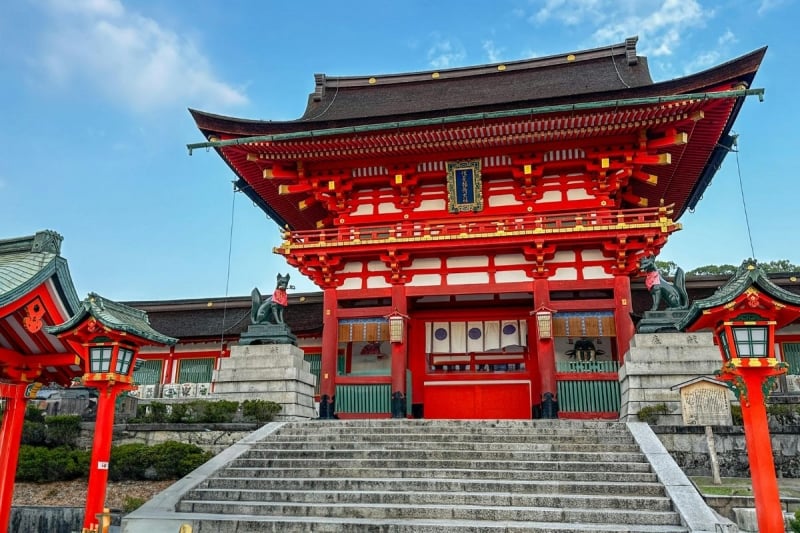
Image Credit: Afif Ramdhasuma via Canva Pro
Start at the large vermilion torii gate at the entrance, then make your way through the Romon Gate and toward the main shrine. If it’s not too crowded, take a moment at the stone basin to rinse your hands. You’ll notice others quietly tossing coins into the offering box, ringing the bell, and following the simple ritual: bow twice, clap twice, bow once more.
From there, head into the Senbon Torii, the most photographed part of the shrine. These tightly packed rows of crimson gates curve uphill, each one a donation from a company or individual hoping for good fortune. Even if you’ve seen the photos, walking through the gates is a different experience — the shifting light, forest sounds, and hum of footsteps give it a rhythm that’s hard to capture on camera.
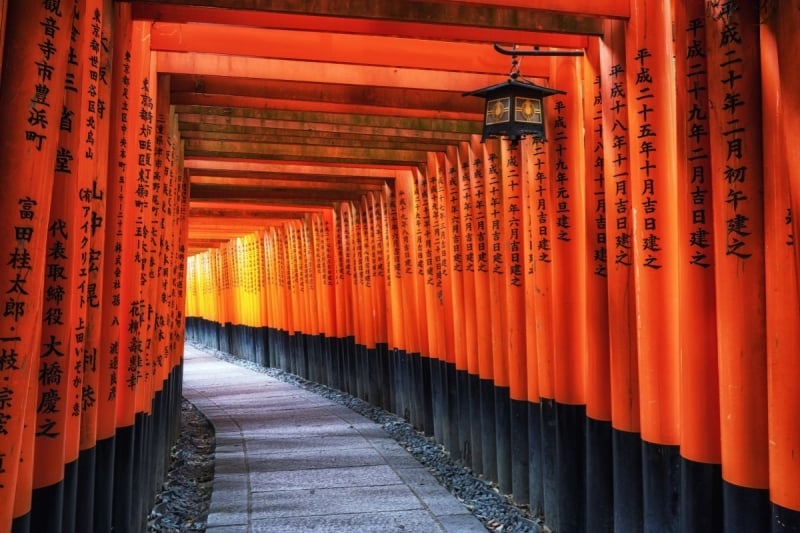
Image Credit: aaron90311 via Canva Pro
If you’re visiting in the afternoon, expect crowds. For a more peaceful walk, go before 8am or after 7pm, when the paths are quieter and the gates are lit by soft lanterns. You’ll still be sharing the space, but it feels more intimate.
Near the entrance, you’ll find small shops selling fox-shaped ema (wooden plaques) for wishes. You can hang one up or keep it as a souvenir. There’s also no pressure to go far. Even a short walk through the torii will give you a feel for the shrine’s atmosphere.
Duration: 45 minutes to 1 hour
Best for: First-timers, travellers on a schedule, anyone who wants the highlights without the full hike
The Trailblazer
You came for more than a photo. You want to walk the whole mountain, feel the slope in your legs, and see what’s beyond the crowds. For that, Fushimi Inari becomes something else entirely.

Image Credit: Daniel Ramirez | Flickr
Once you pass the Senbon Torii and keep going, the gates begin to thin out, the air grows cooler, and the crowds drop off. The climb continues in stages, winding past smaller shrines tucked into the woods, moss-covered stone steps, and quiet lookout points. You’ll pass the Yotsutsuji intersection, which offers a panoramic view of southern Kyoto. Many hikers turn back here, but the trail continues in a loop to the summit if you’re up for it.
Along the way, you’ll find teahouses and vending machines, a welcome surprise on hot days. Some serve shaved ice or kitsune udon (a nod to the fox spirits associated with the shrine).

Image Credit: kaorinne via Canva Pro
This route isn’t technically difficult, but it is long and steep in parts. Still, it’s the journey that makes it worthwhile. As the torii fade into occasional clusters, you start to notice other things: weathered stone foxes, flickers of incense smoke, and the rhythm of your own breathing.
Duration: 2 to 3 hours
Best for: Hikers, repeat visitors, travellers seeking a quieter and more immersive shrine experience
The Midnight Walker
Not a morning person? Not a fan of crowds? Then night might be your best time to visit.
Fushimi Inari is open 24 hours, and there’s something special about wandering through the torii after dark. The gates are lit by gentle floodlights or lanterns, and the shrine grounds take on a more mysterious mood. It’s quieter, cooler, and you’ll often have entire stretches of the trail to yourself.
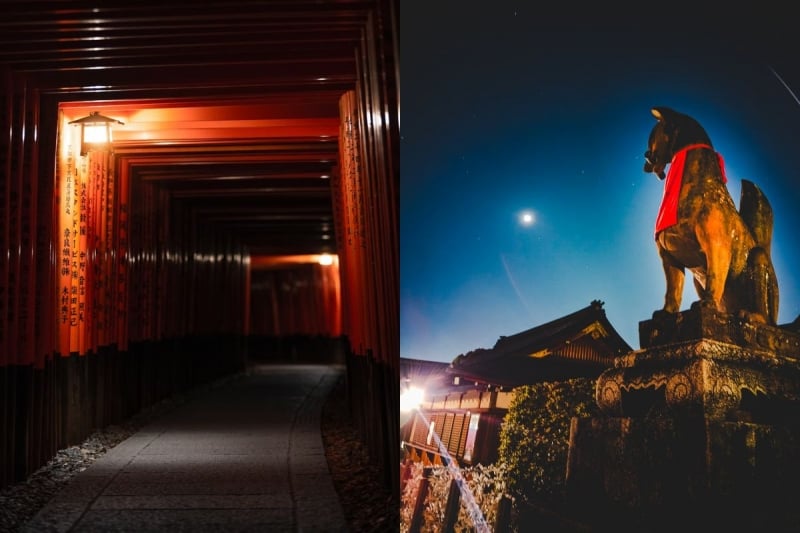
Image Credit: (L-R) Javier Esteban | Unsplash; Ilias Chebbi | Unsplash
There’s also the occasional sense of being watched…but that might just be the fox statues, which appear everywhere once you start noticing them. Each one carries something different in its mouth, like a key, scroll, rice stalk, or jewel.
If you’re visiting in mid-July, time your visit with the Motomiya Festival, when the shrine is decorated with hundreds of glowing paper lanterns. It’s a more local, atmospheric celebration, and the shrine feels like something out of a dream.
Just note that while the paths are lit, parts of the mountain trail can still get very dark. Stick to the main route if you’re unsure, and keep an eye out for signs warning about wild boar.
Duration: 1 to 2 hours
Best for: Night owls, photographers, travellers looking for a quiet and surreal visit
The Hidden Path Explorer
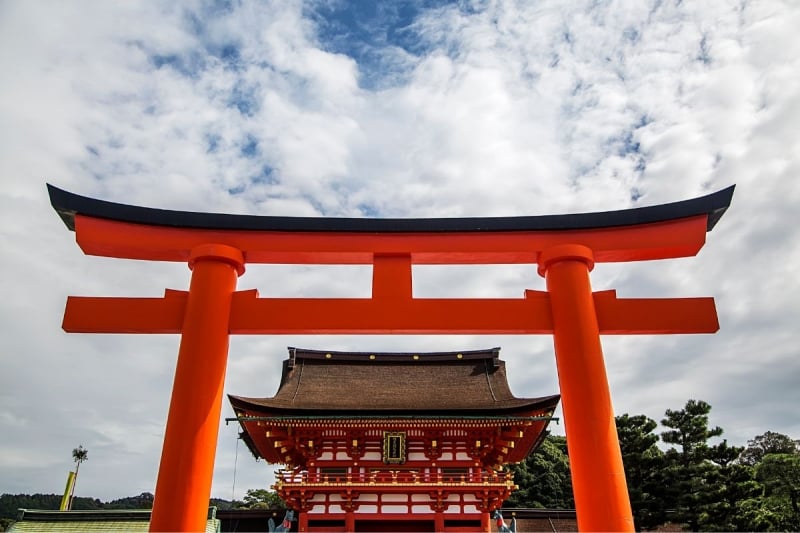
Image Credit: BGStock72 via Canva Pro
If you’re the type who always takes the less obvious turn, Fushimi Inari rewards that curiosity.
Just past the main torii tunnels, there’s a sign in Japanese pointing toward a side path. Follow it, and you’ll find a quiet bamboo forest, tucked away from the main trail. It’s smaller than Arashiyama’s grove but far more peaceful.
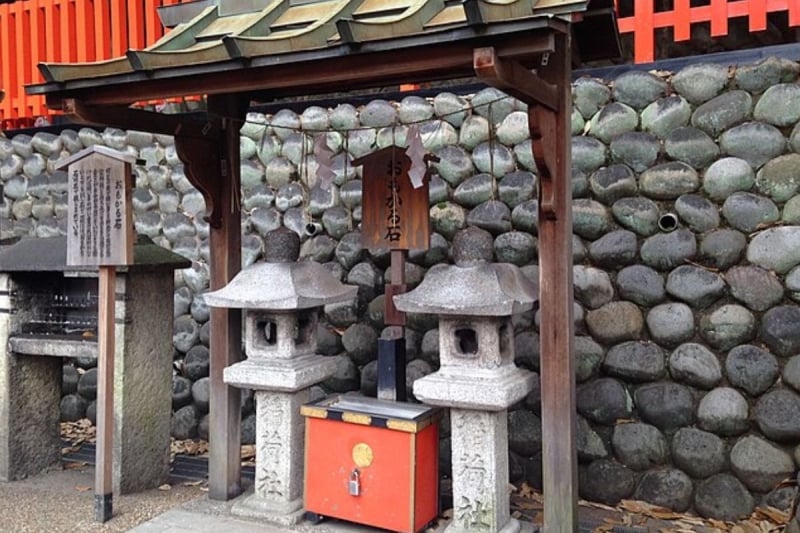
Image Credit: そらみみ via Wikimedia Commons
Keep walking and you’ll reach spots like Omokaru Ishi, a wishing stone where you lift the rock after making a wish. If it feels lighter than expected, your wish is said to come true.
There are also dozens of sub-shrines scattered along the mountain. Some feel almost forgotten, with mossy steps and tiny wooden structures guarded by foxes. Look closely and you’ll see that the fox statues aren’t identical. Each one carries different symbols, adding layers of meaning to the walk if you pause long enough.
Duration: 2 to 2.5 hours
Best for: Curious travellers, folklore lovers, anyone hoping to avoid the main trail entirely
Also read: Where to Buy the Best Matcha in Kyoto (A Matcha Lover’s Guide)
The Devotee
Some come for the photos. Others come to pray.
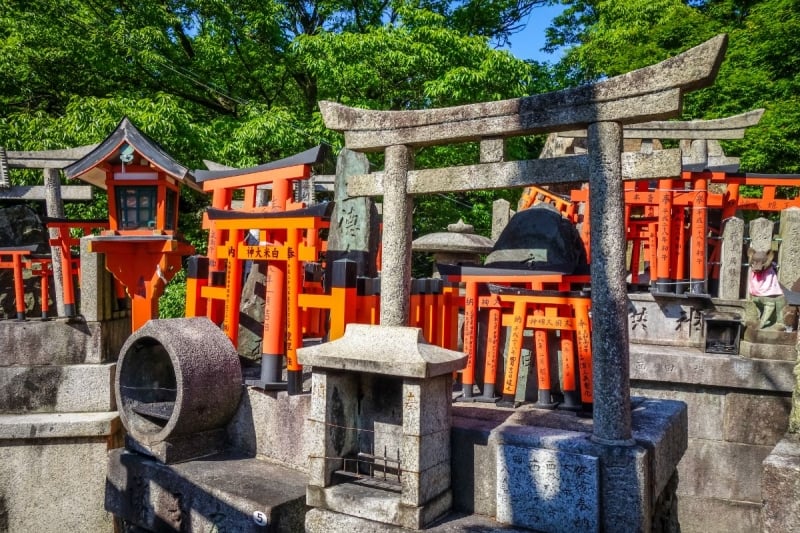
Image Credit: Daboost via Canva Pro
If you’re drawn to the spiritual side of Fushimi Inari, the shrine is full of quiet rituals and small details that are easy to miss. The torii gates are more than photo props. They’re prayers in physical form, donated by individuals and businesses in exchange for blessings.
In the main hall, you’ll notice a mirror instead of a statue. That’s because Inari, like many Shintō deities, isn’t shown in physical form. The mirror reflects your own image — a reminder that the divine might live within us.
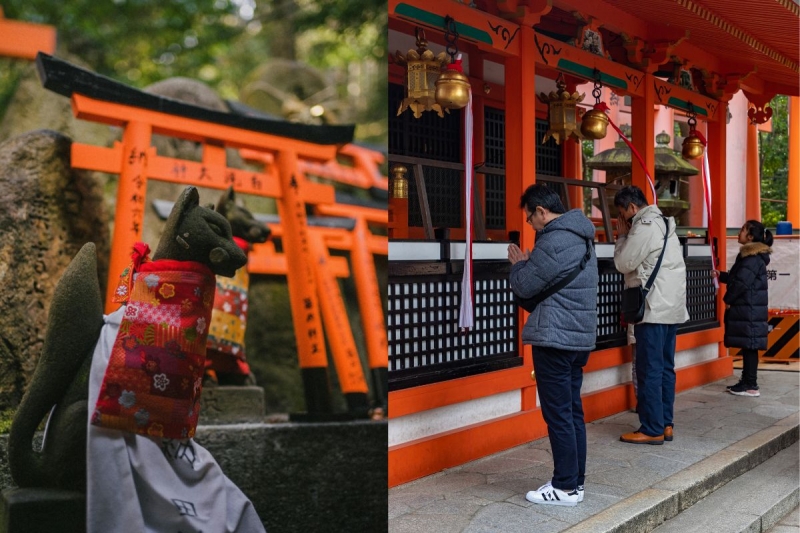
Image Credit: (L-R) Jenny Mavimiro via Canva Pro; Bruno Coelho via Canva Pro
Try the ritual: cleanse your hands at the basin, ring the bell, toss a coin, and bow. There’s no need to rush. Some travellers come in the early morning just for this moment of quiet, before the tour buses arrive.
Whether or not you’re religious, there’s something grounding about watching others pray, seeing locals pass through quickly on their way to work, or noticing how the shrine is still in use, not just a tourist attraction, but a living part of Kyoto.
Duration: Flexible
Best for: Spiritual travellers, those interested in Shintō practices, slow travellers seeking quiet meaning
Also read: 7 Best Ryokans in Kyoto for Autumn 2025: Garden Views, Onsen & Kaiseki
Final thoughts
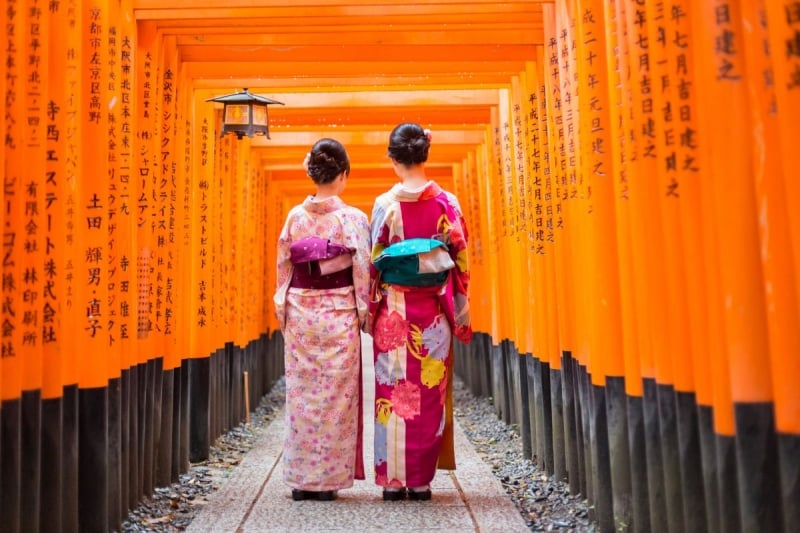
Image Credit: kasto via Canva Pro
One of the best things about Fushimi Inari is that it doesn’t ask anything of you. You can show up for the photo, the hike, the foxes, the folklore, the food, or the prayer, and it will still give you something to remember.
No matter how long you stay or how far you go, you’ll find a version of the shrine that fits the kind of traveller you are. And if you ever return at a different time of day, in a different mood, you might just discover a different Fushimi Inari waiting for you.




